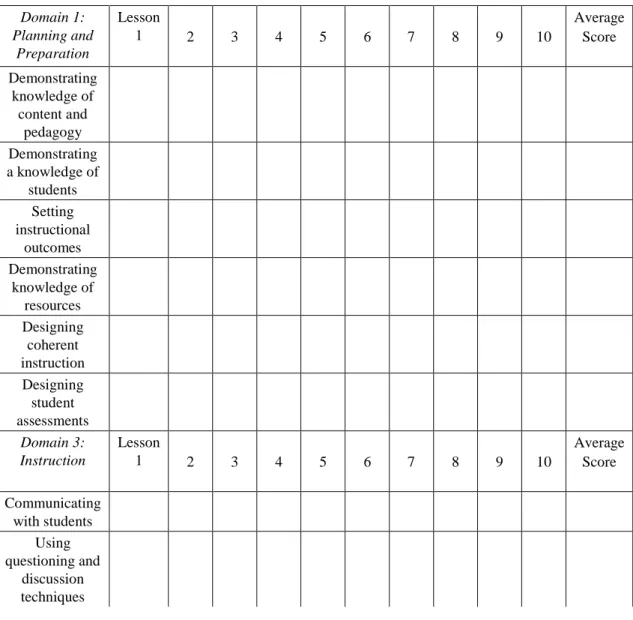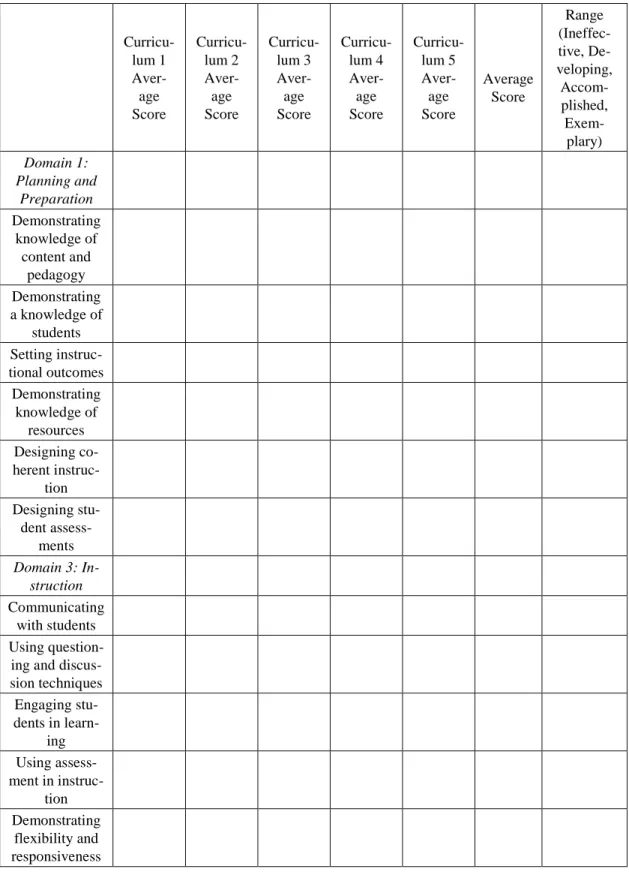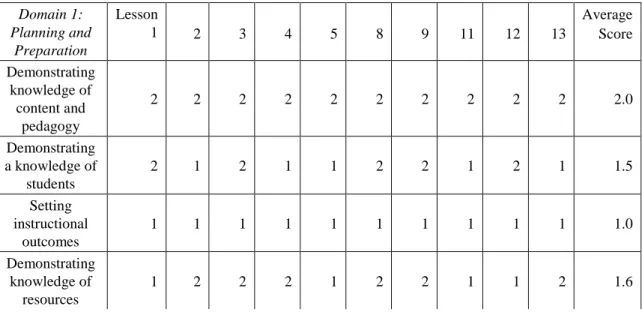This project is not only a reflection of my own work and passion for improving Christian education, but also the reflection of countless individuals who have taught, encouraged, challenged and supported me. John David Trentham persisted in answering my many questions, pushing me to persevere when I wasn't sure I could continue, and has always been such a kind encourager. There are countless people who have challenged me to become a critical thinker and grow as a learner, teacher, and leader.
I am very grateful for the love and support of my parents, Jeff and Carolyn Downing. I am so proud of the young ladies they have become and their hearts for Jesus and His kingdom. While they believe that I have encouraged them to think and revive the Bible, they have also encouraged me to see God's greater plans and purposes and a new passion for impacting the world through being a Christian.
INTRODUCTION
I propose using the Danielson Framework for Teaching (FFT) as an evaluation tool for evaluating curriculum effectiveness. Because of the large number of high school curricula in circulation, the quantitative study focused on evaluating high school student and small group curricula from five of the best-selling published curricula among evangelical churches. The Danielson Framework for Teaching was developed for use in classroom observations; however, since this study focused narrowly on curriculum effectiveness, FFT was used to review and evaluate curricula as opposed to classroom observation.
What are five of the best-selling curricula among evangelical churches for Sunday School classes or small groups in high school? To conduct this research, five of the best-selling evangelical curricula were selected as they represent the largest population of student experiences. These explorable questions are based on using the Danielson Teaching Framework to uncover common strengths and weaknesses in Sunday School or small group high school curricula, as well as factors that can enhance them.
LITERATURE REVIEW
Jim Wilhoit argues that “the question of how to teach can be adequately answered only after the question of the purpose of teaching has been resolved.”10 According to Anthony, “Christian. Plueddemann, “The Power of Piaget,” in Christian Education: Developmental Perspectives on Christian Education, ed. Spiritual maturity involves much more than listening, reading, and cognitive acquisition.18 Howard Hendricks clearly states, "The name of the game in Christian education is not knowledge—it is active obedience."19.
37 Cynthia Jones Neal, “The Power of Vygotsky,” in Wilhoit and Dettoni, Nurture That Is Christian, 130. The learning process is not simply a matter of input and input or mechanical connections; it is better described as a matter of construction and discovery.”69 Furthermore, Ward argues that “the perceptual perception of anything new is always constructed from fragments of previous experiences and understandings.”70 Thus, the role of the teacher or curriculum designer is to create a learning experience for students who makes it easier for them to understand the scriptures. Moore, “The Power of Perry and Belenky,” in Wilhoit and Dettoni, Nurture That Is Christian, 116.
Trentham says, “The social sciences must be approached and qualified with theological conviction, clarity, and wisdom. As an example of earlier beliefs about connecting the social sciences with biblical theology, Karen Estep argues that “the general notion of constructivism does not need to be rejected entirely, as it provides insight into how the individual in a given social context facilitates the learning process and provides methods by which students they can teach.”90 Dave S. Biblical transformation differs from this sense of the goal of transmission: the goal is to read and interpret the Bible not for information but for transformation.92 This difference is illuminated in the Christian pursuit of spiritual transformation, which involves personal and communal engagement with the Bible for transformation.93 Mark Rutter notes that although we live in a culture with an abundance of churches and Christian literature, "the lives of Christians are not necessarily transformed."94 He says that learning is not just behavior, but acting on knowledge, and the goal of the Christian educator is teaching for this transformation with holistic means.95.
Mezirow concludes by arguing, "The professional task before us is to find ways to translate the concept of CRA and its discourse into curricula or programs, methods of instruction, material development, and evaluation criteria."112. To promote a classroom dynamic that is discussion-based and thought-provoking, Daniel Haase presents the phrase "death of the professor" to illustrate the concept of a learning-centered approach to education where the teacher uses his or her knowledge and uses wisdom to become a lead learner and creator of dialogue rather than the purveyor of information.119 Haase adds that "the design bears the burden" as he describes the varying role of the teacher in creating lesson designs in a way that values the learners and the learning more than the lecture.120 This design includes lessons built for dialogue, which is intended not only to engage in conversation, but also to create "rigorous and thoughtful engagement that is built around structured tasks designed for learning". teaches by default on the assumption that if the teacher speaks it, it is known', which turns students into 'containers' or vessels 'to be filled by the teacher'.122. This type of curriculum facilitates "the construction of knowledge by incorporating opportunities for meaningful and authentic exploration, by designing engaging activities, and by using interactive group work."165.
Sullins III, "The Importance of Evaluating Children's Small-Group Curriculum, Kindergarten-Sixth Grade at Churches in Albuquerque, New Mexico" (DEdMin Project, Southwestern Baptist Theological Seminary, 2017) [this thesis focuses on the evaluation of available published curricula according to specific church visions or needs]; Amanda Kathryn Cooley, “Curriculum Resource Evaluation in Southern Baptist Churches in the State of North Carolina” (EdD thesis, Southeastern Baptist Theological Seminary, 2013), xv-4 [this thesis also focuses on evaluation of curricula to meet the needs of churches and students' developmental needs]. The curriculum must be examined and evaluated frequently so that we can ensure that teaching promotes an understanding of God's word, is relevant to the needs of students, and helps move students toward the fullness of Christ.201 Plueddemann states, "One of the best ways to improve .the practice of Christian education in local churches is to do better curriculum evaluation and do it more often.”202 Estep and Estep add that we need to evaluate curricula to assess needs that remain unmet, determine current effectiveness, and decide how to improve that meet the vision established for Christian education.203 They describe curriculum evaluation as "the catalyst for change or. According to Charlotte Danielson, "The framework for teaching is based on the Praxis III criteria developed by the Educational Testing Service (ETS) after extensive studies of the research literature, consultation with experts and researchers, comprehensive job analyses, summaries of state licensing program requirements, and fieldwork.”1.
The ineffective criteria for this component on the FFT are as follows: (1) The teacher sticks to the teaching plan despite evidence of poor student understanding or lack of interest. 2) The teacher ignores student questions; when students have problems, the teacher blames the students or their home environment. The ineffective criteria for this component on the FFT are as follows: (1) Assessment procedures are not congruent with teaching outcomes; the proposed approach contains no criteria or standards. 2) The teacher has no plan to incorporate formative assessment into the lesson or unit nor any plan to use assessment results in the design of future teaching.

CONCLUSION
First, IDM will assist in the establishment, presentation and student understanding of the learning outcomes. First, researchers must remember and focus on the main goal of Christian education presented in chapter 2 (see pp. 18-19): "The goal of Christian education is the promotion of faith development and spiritual formation" and "The ultimate goal of development is that God is glorified as we become more like Christ in all facets of life." This should be the ultimate driver of further evaluation and investigation.The Danielson Framework for Teaching (FFT) can be modified to effectively evaluate curriculum instead of classroom instruction as originally designed.1 The first modification to be implemented to make the FFT effective for curriculum evaluation, is that the word “teacher” (or the teacher's name) should be replaced with the word “curriculum,” and the word “teachers” should be replaced with the word “curricula.” The rest of the sentence will be rewritten if necessary to grammatically match the word "curriculum" or "curriculums".
The teacher has a good idea of the range of interests of the students in the class. The teacher reviews the previous year's cumulative folders to determine the level of knowledge of groups of students in the class. The teacher knows that five of her students are in the Garden Club; plans to discuss horticulture as part of the next biology class.
The curriculum provides materials but does not point to resources outside the curriculum itself. The teacher says: "What is the difference between the formative assessment and the test I give at the end of the unit?". The teacher says, "The district gave me all this curriculum to teach, so I just have to keep going."
Scoring Range Original FFT Language Modified FFT Language Descriptions Develop The teacher's attempt to explain. A student asks, "What are we supposed to do?" and the teacher explains the task. Teacher monitoring of student understanding is sophisticated and continuous: the teacher is constantly "taking the pulse" of the class.
In reflecting on practice, the teacher does not suggest that it is important to reach all students. Achieved If necessary, the teacher adapts the lesson to improve understanding by groups of students. The teacher rearranges the way students are grouped to help students understand the lesson.








